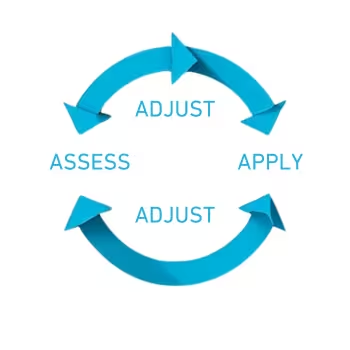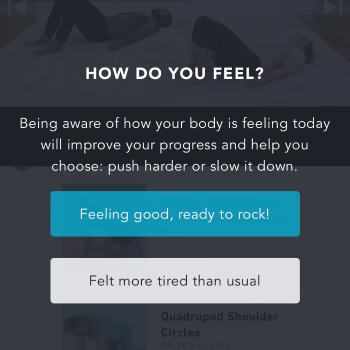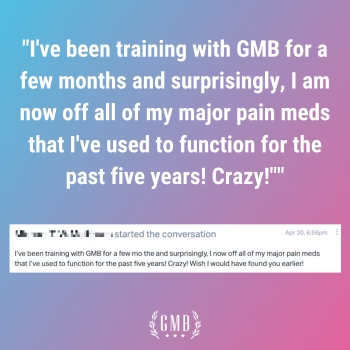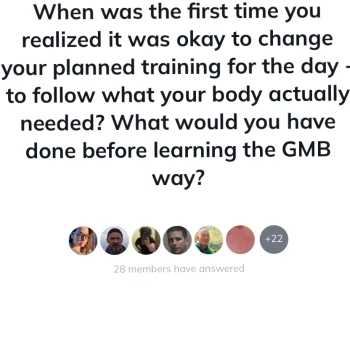Most fitness programs treat your nervous system like an afterthought. As if your body’s readiness, energy, stress levels, or recovery don’t affect how well you move—or whether you want to move at all.
At GMB, we build everything around it — and we’ve been doing that since day one. Back in 2010, our first programs used a 4-phase structure that walked you through natural cycles of pushing and easing off—cycles of nervous system upregulation and downregulation—and from gentle exploration to full expression.
As we expanded into specific skill and mobility work in later programs, that same idea stuck: helping you get to know your body better, and how to adjust your training so you can keep moving forward without burning out.
Because your nervous system isn’t just some hidden switchboard for muscles. It’s the gatekeeper of learning, the thermostat for energy output, and the smoke alarm that sounds when you’re running too hot.
And if your training doesn’t respect that? You’re gonna feel it—burnout, stiffness, poor coordination, and a creeping sense that things just aren’t clicking anymore.
What It Actually Means to Train With Your Nervous System
 When we talk about nervous system regulation in training, we’re referring to your body’s ability to upregulate (gear up, focus, perform) and downregulate (rest, repair, calm) based on what’s happening inside and around you.
When we talk about nervous system regulation in training, we’re referring to your body’s ability to upregulate (gear up, focus, perform) and downregulate (rest, repair, calm) based on what’s happening inside and around you.
Everything from work stress, sleep quality, nutrition, illness, and past injury history affects how your nervous system behaves on any given day. And all of that impacts how you move.
Think of your nervous system as your movement governor. When it’s dialed in, you’re focused, coordinated, and learning faster. When it’s fried or out of sync, even basic movements feel clumsy and effortful. Most programs are locked into rigid schedules and assume every training day should look the same. Same reps, same volume, same intensity—regardless of whether you slept four hours or are coming off a head cold.
The result? People crash. Not because they’re weak or undisciplined, but because their systems are too overloaded to adapt.
This is especially true for adults juggling work, parenting, and inconsistent sleep. Your body isn’t a machine—it’s more like a jazz band. You need enough control to stay in rhythm, but enough freedom to improvise.
How GMB Builds Training With Your Nervous System, Not Against It
 Every GMB program—Elements, Mobility, Integral Strength, Sequences—builds in flexibility and responsiveness. Here’s how that looks in practice:
Every GMB program—Elements, Mobility, Integral Strength, Sequences—builds in flexibility and responsiveness. Here’s how that looks in practice:
- Adjustable Sessions: You don’t need (and shouldn’t!) make every session the same. Autoregulation is built-in to every session to account for your nervous system condition
- Built-In Variety: Sessions alternate the focus in different attributes—coordination, strength type, mobility—so you’re not overstressing the same things every day.
- Pace and Intensity Control: You’re encouraged to modulate tempo and movement variations based on how you’re performing that day. We give guidance, not rigid rules.
- Emphasis on Awareness: We coach you to pay attention—not just to performance, but to how you’re responding.
This isn’t about going easy. It’s about going smart. So you can stay consistent without forcing your body into corners it doesn’t want to be in that day.
Your Nervous System Is the Gatekeeper to Skill, Focus, and Progress
We don’t just care about effort—we care about learning. And your nervous system has to be in the right state for that to happen.
High stress, fatigue, or overload impair motor control and coordination. Your brain doesn’t retain patterns as well. You move like you’re fighting yourself.
But when you’re regulated—calm but alert—that’s when things click. That’s when you feel connected. That’s when skills stick.
View this post on Instagram
This is how we’ve been teaching for decades and research backs this up. Studies show that training under high fatigue impairs motor learning and coordination, while individualized, fatigue-controlled training improves outcomes and helps the brain wire in better movement patterns.
A great review on the role of the nervous system in exercise, Neuroscience & Biobehavioral Reviews illustrates that autonomic nervous system (ANS) balance, particularly higher parasympathetic (vagal) tone, is linked to better exercise recovery and motor learning responses. Individual variability in ANS function means some people respond better to certain types of training—and ignoring this is a fast track to inconsistent results and burnout.
Programs that account for this variability—like those that are baked into our programs—are more likely to lead to consistent, long-term success.
This review in the Annals of Physical and Rehabilitation Medicine tells us that fatigue isn’t just muscular—it’s centrally driven too. Central fatigue, which originates in the nervous system, reduces the neural drive to your muscles. And crucially, training that accounts for this can reduce fatigue’s impact over time, improving both performance and consistency.
Regular, well-regulated training enhances neuromuscular efficiency and helps keep both brain and body in sync—exactly what we aim for in all of our programs.
This nice synopsis in Autonomic Neuroscience has shown that regular exercise improves the balance between sympathetic and parasympathetic activity—enhancing autonomic regulation. Lower resting sympathetic activity and better recovery capacity mean your nervous system is more adaptable. The payoff? More consistent training, better overall resilience, and improved health outcomes over time.
Want to Move Better? Start With a Nervous System That Can Learn
At GMB, we’ve always emphasized movement quality over chasing more and more quantity without purpose—and that’s not just opinion, it’s how your nervous system learns best.
When you’re in a regulated state—alert, focused, but not overwhelmed—you’re primed to actually learn. That’s when you can build new coordination patterns, refine control, and integrate what your body’s doing with what your brain’s asking for.
Trying to push through high fatigue or stress? Your nervous system isn’t in a state where it can retain those patterns. You’re more likely to move poorly, reinforce bad habits, or just burn out. That’s why we emphasize adjusting intensity, matching challenge to ability, and using variation intentionally.
You’re not just saving energy when you adjust for fatigue—you’re training your nervous system to move better, learn faster, and stay in the game longer.
Nervous system regulation is more than making things easier when they need to be. It’s the foundation for getting better at movement in the first place.
And just like your nervous system helps you move better, it’s also behind how you respond to pain—whether it shuts you down or just gives you something to pay attention to.
Your Nervous System Modulates Pain—Regulated Training Helps Turn the Volume Down
 Pain isn’t necessarily a sign that something’s broken—but it is a very real signal that your nervous system is sensing a threat. That threat could be physical, like trauma or a repetitive strain you just aren’t ready for. But it’s also tied to your entire environment—stress (financial, emotional, etc.), poor sleep, even rapid changes in location or diet.
Pain isn’t necessarily a sign that something’s broken—but it is a very real signal that your nervous system is sensing a threat. That threat could be physical, like trauma or a repetitive strain you just aren’t ready for. But it’s also tied to your entire environment—stress (financial, emotional, etc.), poor sleep, even rapid changes in location or diet.
The important part?
Your nervous system doesn’t just react to pain—it shapes it. Train with awareness, and you’re teaching your system to feel safe again.
The more dysregulated or overstimulated your system is, the more likely it is to interpret movement as dangerous, even when there’s no injury. That’s why autoregulation and nervous system awareness are so powerful. When you tune into your state, adjust intensity, and train with a sense of awareness instead of urgency, you’re giving evidence that everything is ok. And that’s often the first step toward moving better—and feeling better.
What Happens When You Start Training This Way
 Here’s what a few of our clients noticed when they started training with their nervous systems instead of fighting them:
Here’s what a few of our clients noticed when they started training with their nervous systems instead of fighting them:
“I think what made me realise it was I just sick of being knackered and trudging through. Before GMB I probably would have just skipped it completely or just done a slightly lighter version of the planned thing that body still didn’t need. ”
“I have recognized and internalized that, it isn’t a tool to practice “less” but indeed a tool to practice “more” by ensuring consistency. I am no more shaming myself when and if a day is lighter than planned.”
“GMB taught me to understand progress experientially, through awareness – noticing what I could suddenly do that I couldn’t do before, and usually without even trying to actually achieve that thing. What’s better than actually being surprised by your own progress because you’re just enjoying yourself and focusing on doing things with quality?”
That exploration only works if your system is in a state where it can process new inputs. GMB doesn’t just allow that—it’s built around it.
Consistency Isn’t About Willpower—It’s About Regulation
 While intensity and variety often steal the spotlight in fitness discussions, it’s consistency that truly drives long-term success. A comprehensive analysis by researchers at the University of New South Wales, which reviewed 24 resistance training studies involving nearly 1,000 women, found that variables like exercise selection, weight load, and supervision had less impact on strength and muscle growth than consistent training habits.
While intensity and variety often steal the spotlight in fitness discussions, it’s consistency that truly drives long-term success. A comprehensive analysis by researchers at the University of New South Wales, which reviewed 24 resistance training studies involving nearly 1,000 women, found that variables like exercise selection, weight load, and supervision had less impact on strength and muscle growth than consistent training habits.
Further supporting this, a study published in the Journal of the American Heart Association revealed that regular moderate exercise throughout the week was more effective at reducing cardiovascular risk than sporadic high-intensity sessions.
These findings underscore that maintaining a consistent exercise routine, even with moderate intensity, can be just as beneficial for long-term health than intermittent high-intensity workouts.
Why Regulated Training Keeps You Coming Back
Consistency doesn’t require “willpower” (whatever that means)— a lot of it is dependent upon how your nervous system feels about showing up again tomorrow. Remember that our brains want to protect us!
When your training respects nervous system regulation, it lowers the overall cost of participation. You’re not constantly dragging yourself through sessions your body’s not ready for. You’re not stacking tension on top of tension until you need a week (or a month) off to recover.
Instead, you’re creating an internal environment where training feels sustainable and even enjoyable—day after day.
- You feel more capable. Regulated states reduce overwhelm. When your system feels balanced, you’re more likely to want to train because it doesn’t feel like another stressful demand.
- You recover more predictably. Downregulation-focused sessions—like slower mobility work or mindful movement—enhance parasympathetic activity, which helps your body repair more efficiently.
- You avoid the boom-and-bust cycle. Regulation helps you avoid overtraining, crash-and-burn cycles, and guilt-induced overcompensation.
- You build trust in your body. Safe, do-able sessions make it easier to stop second-guessing and start showing up with confidence.
- You internalize a rhythm. Your nervous system starts to expect and enjoy that consistent routine—and that’s how real transformation happens.
Train for the Long Haul—With a Body You Can Actually Trust
When your training respects your nervous system, you don’t just avoid injury—you start to trust your body again.
You train consistently, not because you force yourself to, but because it feels good to move. You improve your coordination, reduce nagging pain, and reclaim movement patterns you thought you lost.
Most important of all—you stop second-guessing what your body can do. Because you’ve built that ability from the inside out, in partnership with your own system.
Learn The Foundation For Consistent, Capable Movement
With Elements, you’ll build a foundation of strength, flexibility, and control while respecting your nervous system’s needs.


